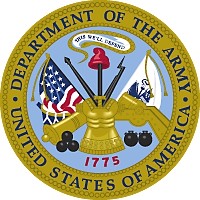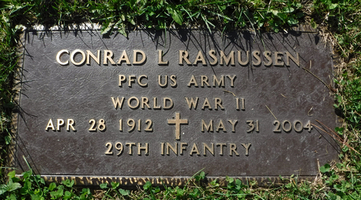Skip to content
Conrad Leo Rasmussen
Lilah Crowe2020-06-14T14:24:35-05:00
- Name: Conrad Leo Rasmussen
- Location of Birth: Splithand Township, Itasca County, Minnesota
- Date of Birth: April 28, 1912
- Date of Death: May 31, 2004 (92 years old)
- Parents: Gutfred Rasmus Rasmussen and Hannah M. (Jorgensen) Rasmussen
- High School and Class: 1930 - Grand Rapids High School, Grand Rapids, Minnesota
- College:
- Highest Rank: PFC (Private First Class)
- Branch: Army
- Other Branch:
- Date Sworn In: November 30, 1943
- Place Sworn In:
- Date of Discharge: February 14, 1946
- Place of Discharge: Camp Carson at Colorado Springs, Colorado
-
- Military Awards:
- Military Highlights:
Served in the 29th Infantry
- Wars Involved:
World War II
- MIA / POW:
- Civilian Life:
Lived in Deer River, Minnesota, owned a logging company, worked construction and drove trucks. During retirement he sold Watkins.
News article written by David A. Ott, contributing writer for the Western Itasca Review, dated July 8, 1993:
A familiar face
Whenever I'm asked about Deer River from friends or acquaintances that live in other places, the most common remark sounds something like, "I bet you know everyone in the whole town!" To this statement I usually reply "yes" or simply agree, but it wasn't until very recently that I realized I was only telling half truths.
The beauty about small town life is that, on almost any given day, you can stroll through town and run into people that you "know." Faces are familiar and so are names on most occasions, but it is highly unusual that anything more than these basic elements are known. It is astonishing how many people in our town have interesting stories to tell, if only someone would take the time to listen.
Conrad Rasmussen is someone I have "known" for many years. By either running into him at the Post Office or grocery store, or seeing him driving around town, Conrad has always been one of those familiar faces I have come to associate with life in Deer River. It wasn't until I was able to speak with Conrad and make a formal introduction that I realized what an interesting story he had to tell.
The Early Years
Conrad Rasmussen was born April 28, 1912, in Splithand the eighth child of ten, having six sisters and three brothers. He recalls a happy childhood. "My home was filled with music" says Conrad. "We all sang as we worked. We had a Pathe Phonograph and a lot of good records."
After attending the Splithand rural schools, Conrad took the train from Rabey to Swan River, then transferred onto the Great Northern which took him into Grand Rapids where he attended high school. Because of the great distance between his home and the school, Conrad was forced to live in Grand Rapids away from his family while attending high school. "I worked for my room and board at Mahaupt's 10 Cent Store. I was only able to get home three times a year."
Conrad entered into the first of several early business excursions when he was 20 and his brother Henry (now deceased) was 22. Conrad and Henry were employed by M. J. Salisbury as truckers who hauled mining timber to the mines and Blandin Paper Mill.
Anyone who know Conrad will confess that his kindness and courtesy are beyond compare. As a young man, Conrad displayed the same qualities. "When Henry and I were trucking we would see people in trouble with stalled vehicles and help them out. One woman that we helped by giving her a ride to a garage saw us 20 years later and thanked us again."
During a trip hauling cedar posts to Mayville, North Dakota, Conrad recalls a particularly interesting radio broadcast. "We stopped at a drug store to buy some pop and I heard on the radio that the Grand Rapids Bank had been held up and Mrs. McDonald was taken hostage. During their get-away, the robbers poured roofing nails on the highway behind them. Luckily, Mrs. McDonald was released without harm."
In 1938, Conrad married Ruth Hildeton a teacher at Cowhorn School south of Grand Rapids. "Before Ruth and I were married, I took a stand for the Lord. He has seen us through 55 years.
The United States' involvement in World War II saw brother Henry drafted. Conrad continued the trucking business by himself for a short time before taking a sheet metal course in Minneapolis. He and Ruth then moved to San Diego, California, where Conrad worked for Consolidated Aircraft. After learning of an airplane repair plant opening back home in Minnesota, Conrad asked for a transfer and was sent to St. Cloud.
Conrad soon came to the realization that inside work wasn't for him, and traveled to Minneapolis to sign up to work on the Alaskan Highway. "When I got home to St. Cloud and told Ruth what I had done, all she could say was "That will be a cold place to work."
During his stay in Alaska, Conrad faced many new experiences. One day while cleaning up a camp site, Conrad and his co-workers came face to face with nature. "When we got there, we were met by a huge brown bear. I took a double bitted axe and walked toward the bear, hoping to scare it away. He stopped and I quickly changed my mind. At the time, I thought they were just like Minnesota brown bears, but I was wrong."
World War II
Following his stint on the Alaskan Highway, Conrad returned to St. Cloud and his wife Ruth. A month later, he and Ruth celebrated the birth of their son, Wesley, and Conrad waited for his draft notification. Upon receiving notice, he traveled to Camp Blending, Fla. for four months of basic training. Conrad admits that basic training was difficult but being in good physical shape, he was able to take it. "I felt sorry for the boys who were 19-20 years old," says Conrad. "I saw a lot of them fall on their face...basic training was not a baseball game."
Following a short furlough in June of 1944 when he was able to see Ruth and Wesley, Conrad boarded the troop carrier Monticello and traveled to Liverpool, England. The time eventually came for Conrad and the 29th Infantry to cross the English Channel. Soon after D-Day, they landed on Oma Beach and then went by truck to Brest, France. After a bombing raid, the 29th Infantry was sent into battle to relieve the Rangers. "We met Hitler's elite troops in the battle at Brest," recalls Conrad. "Only 45 of the original 130 soldiers in our Infantry survived."
During the battle, a bomb was dropped very near Conrad and he received a concussion. He was sent into northern England for treatment, but returned to action very quickly. "I rejoined my Infantry. We were sent through Belgium into Germany. As we traveled, we could see farmers in the fields harvesting potatoes."
After battle in Germany, he received further injuries and was sent back to the hospital for treatment. Following his release, Conrad was reclassified to Ordinance in Salsbury (Salisbury), England. "We received orders to move the Ordinance to Belgium, so we crossed the channel again into France. As we arrived, we learned that the war was over."
A Return to the Northwoods
Conrad returned to the U.S. on the Liberty and was discharged at Camp Carson on February 14, 1946. He returned to Deer River and was reunited with his wife and son, who had returned to the area when he was sent overseas.
Conrad found employment with the John Falks Creamery as a driving salesman on the Iron Range. but really wanted to get back in the woods again. He hired 15 men for a logging job but due to an outbreak of poison ivy, he was forced to quit the job.
Over the years, Conrad has held many occupations including mining, construction, and driving truck. For several years he cut and sold Christmas trees, one load of which was sent to Hollywood, California.
Conrad loves the Deer River area and finds its people very congenial. He has, and continues to be very active with the Bethany Lutheran Church and its activities. In recent years, Conrad and his wife Ruth have kept busy by selling Fuller Brush Products, taking drives and short vacations, and visiting friends and acquaintances."
Conrad attended Splithand School and Grand Rapids High School. He and his brother Henry formed a trucking company which they operated for 10 years. They logged and hauled timber for the iron mines and to the Dakotas.
Conrad married Ruth Hildeton on June 5, 1938.
He was employed in the airplane factories in San Diego, California and St. Cloud, Minnesota, worked on the Al-Can Highway, and following reclassification, was drafted into the Army and was a combat veteran of the European Theater. He was honorably discharged in 1946.
Following discharge he was employed by J. E. Falk-Deer River Creamery for five years and was in the logging business for many years. He then was employed by Hawkinson Construction Company for twenty years prior to retirement. In addition he was employed in the iron mines for a few years and in retirement sold Fuller Brush products.
Conrad's first wife, Ruth, died in 1995 and later in the same year, he was married to Delight Corwin.
Conrad was a charter member of Bethany Lutheran Church of Deer River, Minnesota and was a member of the Deer River Veterans of Foreign Wars Post 2720.
He will be remembered for his smile and his cheerful, joking way. He will be dearly missed by his family and friends.
He is survived by his second wife, Delight Corwin Rasmussen; son, Wesley, stepson, Jim (Virginia) Corwin; stepdaughter Starlet (Don) Mayer; seven step-grandchildren and many great-grandchildren.
Preceding him in death were his wife, Ruth; sisters, Laura Eastman, Nora Modrynsky, Emma Hegg, Agnes Burt, Minnie Floyd, and Helen Maxfield; and three brothers, Clarence, Henry, and Ernest.
Buried in Pine Ridge Cemetery at Deer River, Minnesota.
- Tribal Affiliation(s):
Page load link


